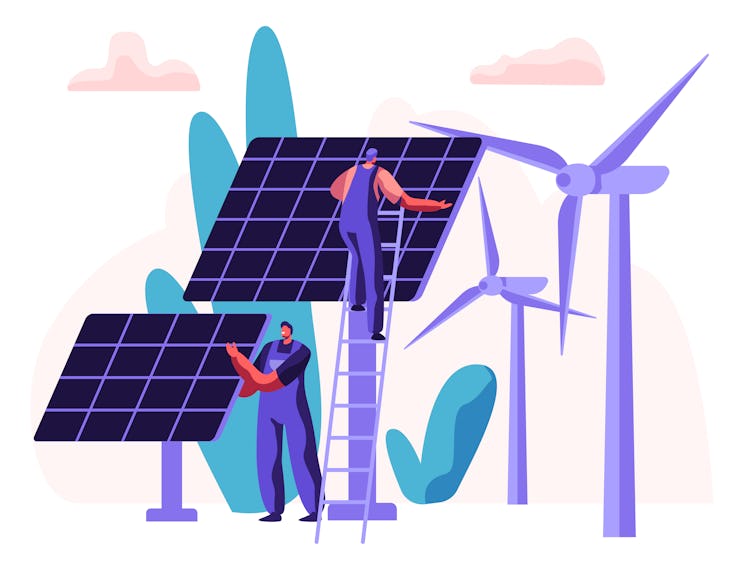35
percent more solar energy
Joule

This smart twist could revolutionize solar energy
An analysis of different solar panel models has found that double-sided solar panels that tilt toward the sun are the most cost-effective.
Solar energy is no longer the new kid on the block. In fact, in many places around the world, solar-created electricity is now cheaper than its coal-generated counterpart. Yet, despite the rising popularity of this energy giant, solar energy innovation has been notoriously slow. But findings from a new worldwide analysis of solar energy operations could jumpstart a whole new era of solar energy.
The study focused on the difference between using a traditional, single-sided solar panel and a double-sided, sun-tracking panel. By looking at data from across the world, researchers found that double-sided solar panels created more energy per panel in 93.1 percent of the world, creating a 35 percent increase in energy output.
While double-sided and tracking solar panel designs have notoriously been more expensive than single panel models, this analysis shows that making the switch would be worth the risk.
While the benefits of double-sided and tracking solar panels have been widely researched prior to this, in a study, published Wednesday in the journal Joule, an international team of researchers explains that their approach contributes new information because it focuses on a specific measure for solar energy: LCOE (levelized cost of electricity.) Essentially, LCOE is a cost and benefit analysis comparing the energy output of a solar panel over its lifetime with its operating costs.
Evaluating this aspect of the innovation is essential, says first author Carlos Rodríguez-Gallegos, a research fellow at the Solar Energy Research Institute of Singapore, in a statement. This analysis, combined with previous research, can provide essential evidence the industry needs in order to move forward
"The photovoltaics market is traditionally conservative," says Rodríguez-Gallegos. "More and more evidence points toward bifacial and tracking technology to be reliable, and we see more and more of it adopted in the field. Still, transitions take time, and time will have to show whether the advantages we see are attractive enough for installers to make the switch."
The researchers found that single-axis trackers with double-sided models had the lowest LCOE in the majority of locations and that energy yield was boosted by 35% by using a double-sided model with single-axis trackers.
To make their analysis the team used data from NASA's Clouds and the Earth's Radiant Energy System (CERES) to measure the total solar radiation that hits the ground daily. They then calculated how much radiation could be captured by solar panels of different types, including single panel, double panel, and rotating designs. Finally, to calculate LCOE, they compared how the cost of operation over the panels' lifetimes to their energy output.
"As long as research continues to take place, the manufacturing costs of these materials are expected to keep on decreasing [and] become economically competitive [enough for] your roof."
By the end of this analysis, the researchers say that double-sided panels with single-axis tracking emerged as the clear winner, being most cost-effective in over 90 percent of the globe. They also demonstrated a 35 percent increase in energy yield compared to single-panel models.
For the remaining less than 10 percent of the globe, mostly around the northern and southern poles, double-sided panels with double-axis tracking were more effective (though more expensive) and showed a 40 percent higher energy yield.
Rodríguez-Gallegos writes in a statement that he hopes the clear benefits of double-sided solar panels demonstrated in this study can help move the entire industry toward a more cost-effective model, which will ultimately make it easier for consumers to access these green technologies.
"As long as research continues to take place, the manufacturing costs of these materials are expected to keep on decreasing, and a point in time might be reached when they become economically competitive and you might see them on your roof," says Rodríguez-Gallegos. "We then aim to be a step ahead of this potential future so that our research can be used as a guide for scientists, manufacturers, installers, and investors."
Abstract: This work presents a worldwide analysis on the yield potential and cost effectiveness of photovoltaic farms composed of monofacial fixed-tilt and single/dual (1T/2T) tracker installations, as well as their bifacial counterparts. Our approach starts by estimating the irradiance reaching both the front and rear surfaces of the modules for the different system designs (validated based on data from real photovoltaic systems and results from the literature) to estimate their energy production. Subsequently, the overall system cost during their 25-year lifetime is factored in, and the levelized cost of electricity (LCOE) is obtained. The results reveal that bifacial-1T installations increase energy yield by 35% and reach the lowest LCOE for the majority of the world (93.1% of the land area). Although dual-axis trackers achieve the highest energy generation, their costs are still too high and are therefore not as cost effective. Sensitivity analyses are also provided to show the general robustness of our findings.